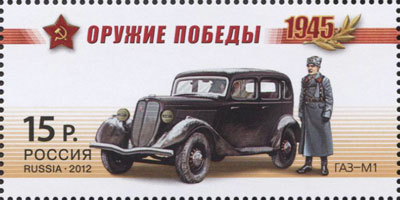|
GAZ-MM
The GAZ-MM is a Soviet light truck produced at the Gorki Auto Plant from 1938 to 1947, and then at the Ulyanovsky Auto Plant up to 1956. The truck was a modernized and improved variant of the GAZ-AA that used the more powerful engine from the GAZ-M1, upgrading the vehicle's power to 50 hp. Other improvements included a reinforced suspension, alongside a new steering and cardan shaft. The styling also slightly changed, incorporating simple angular fenders, rather than the GAZ-AA's more rounded ones. Due to some engine shortages at the factory, some believe that the actual mass-production of the GAZ-MM trucks only started in 1940, since the GAZ-M1 engine needed to get firstly used in the GAZ-AAA and BA-10 vehicles. In 1942 a simplified variant of the truck, with the ''GAZ-MM-V'' index started getting produced, due to material shortages, but limited production of the original "unsimplified" GAZ-MM continued. In 1943 the second headlight was re-added, and a simplified wooden cabin ... [...More Info...] [...Related Items...] OR: [Wikipedia] [Google] [Baidu] |
25 Mm Automatic Air Defense Gun M1940 (72-K)
25 mm automatic air defense gun M1940 (72-K) () was a Soviet Union, Soviet 25 mm caliber anti-aircraft gun used during the World War II. The gun was developed from the end of 1939 to the beginning of 1940 at 8th Kalinin Artillery Plant under the guidance of its Chief Designer Mikhail Loginov, supervised by Lev Loktev. The cannon was given the factory code 72-K before being accepted into service by the Red Army as the 25 mm automatic air defense gun M1940. The gun borrowed a number of features from the older 37 mm automatic air defense gun M1939, such as mounting the gun on an integral four-wheel chassis (which came under criticism when compared to similar anti-aircraft guns from outside the Soviet Union). The gun itself generally satisfied the Army, and its ballistic performance was considered state-of-the-art on the world level. The 72-K was designed for anti-aircraft defense for infantry regiments, occupying a place between the large-caliber DShK and the mor ... [...More Info...] [...Related Items...] OR: [Wikipedia] [Google] [Baidu] |
GAZ-M1
The GAZ M1 (“Эмка“/”Emka”) was a passenger car produced by the Automotive industry in the Soviet Union, Soviet automaker GAZ between 1936 and 1943, at their plant in Nizhny Novgorod, Gorky (now Nizhny Novgorod, Russia). Systematic production ended in 1941, but the factory was able to continue assembling cars from existing inventory of parts and components until 1943. In total, 62,888 GAZ M1 automobiles were produced. Much of the car's production period coincided with the Great Patriotic War, Great Patriotic War (World War II), and many ''Emkas'', as they were commonly called, were used by the Red Army, army as staff cars. Various special versions were produced such as the FAI armoured car, GAZ M - FAI and BA-20 armoured car models. The car has subsequently become an icon of its time in Russia, having been relatively popular, and featuring in film and photographic images of a defining period in the history of the Soviet Union. Background The Soviet Union's first pas ... [...More Info...] [...Related Items...] OR: [Wikipedia] [Google] [Baidu] |
GAZ-AA
The GAZ-AA is a truck produced at the GAZ, Gorky Auto Plant in the Soviet Union from 1932 to 1938, and was the factory's first truck produced under the ''GAZ'' brand. Russian-speakers often refer to it as a ''polutorka'' () - meaning "one-and-a halfer", with reference to its carrying capacity of 1.5 tonnes (1500 kilograms). History On 31 May 1929, the Supreme Soviet of the National Economy of the Soviet Union () made an agreement with the Ford Motor Company to produce Ford Model A (1927–1931), Ford Model A and Ford Model AA, Model AA vehicles, and the Soviet ''Metallostroy'' organisation () started constructing an American-designed automotive plant in Nizhny-Novgorod. Initially, 10 Ford Model AA trucks were built at the plant, under the name ''NAZ'' (for Nizhny Novgorod Avtomobilny Zavod). Soviet engineers prepared their own mechanical blueprints for production, specifying a truck to be made with thicker steel and to have an upgraded suspension system. In 1932, the city of ... [...More Info...] [...Related Items...] OR: [Wikipedia] [Google] [Baidu] |
GAZ Group Trucks
Gaz may refer to: Geography *Gaz, Kyrgyzstan Iran * Gaz, Darmian, village in South Khorasan province * Gaz, Golestan, a village in Bandar-e Gaz County * Gaz, Hormozgan, a village in Minab County * Gaz, Kerman, a village * Gaz, North Khorasan, a village * Gaz, Ravar, a village in Kerman province * Gaz, Sarbisheh, village in South Khorasan province * Gaz, Semnan, a village in Damghan County * Gaz-e Borkhar, a city in Isfahan province * Gaz-e Gharbi, a village in Bandar-e Gaz County, Golestan province * Gaz-e Lang, a village in Anbarabad County, Kerman province * Bandar-e-gaz County, Golestan province People Given name *Gaz Beadle (born 1988), TV actor in ''Geordie Shore'' *Gaz Coombes (born 1976), in the band Supergrass * Gaz Liddon, British games reviewer Stage name *Gaz, former drummer of Malice Mizer and Baiser Surname *Mohammad Al Gaz, UAE businessman Arts, entertainment, and media Fictional characters * Gaz (''Call of Duty 4''), SAS soldier in the 2007 video game * Kyle " ... [...More Info...] [...Related Items...] OR: [Wikipedia] [Google] [Baidu] |
GAZ-51
The GAZ-51 (Russian: ГАЗ-51) is a light truck manufactured by the Soviet vehicle manufacturer GAZ, Gorkovsky Avtomobilny Zavod. The vehicle was designed before the World War II, Second World War and mass-produced together with the all-wheel-drive version GAZ-63 after the end of the war. Under the designation GAZ-93, a Dump truck, tipper was produced on the basis of the GAZ-51. The GAZ-51 was a 4x2 2.5 ton truck while the GAZ-63 had all-wheel drive.инженер Л. Шугуров. Грузовики // журнал "Nauka i Zhizn, Наука и жизнь", № 12, 1979. стр.30-32 History The ideas for the development of the GAZ-51 date back to the mid-1930s. The GAZ-AA proved to be increasingly outdated, even by Soviet standards. The American model, the Ford Model AA, Ford AA, had already been taken out of production in 1931. Accordingly, the GAZ-11-51 was designed from February 1937, a light truck with a more powerful engine and a completely revised cab. The latter ... [...More Info...] [...Related Items...] OR: [Wikipedia] [Google] [Baidu] |
GAZ-AAA
The GAZ-AAA was a Soviet truck produced by GAZ. From 1936 to 1943, 37,373 units were built. Like the GAZ-AA and GAZ-MM, it was largely based on the Ford Model AA truck. The Red Army commonly used these trucks as anti-aircraft units, mounting either 4 7.62mm Maxim guns (as seen on the 4M variant), one 12.7mm DShK The DShK M1938 (Cyrillic: ДШК, for ) is a Soviet heavy machine gun. The weapon may be vehicle mounted or used on a tripod or wheeled carriage as a heavy infantry machine gun. The DShK's name is derived from its original designer, Vasily Degtya ... heavy machine gun, or a single 25mm 72-K autocannon. The GAZ-AAA, being a development of the GAZ-AA, involved several modifications, the most noticeable, of which, was a 6-wheeled base rather than the 4-wheeled original. References External links GAZ-AAA in the Vladivostok Museum of Automotive Antiques 1930s cars Cars discontinued in 1943 GAZ Group trucks Military vehicles introduced in the 1930s {{ ... [...More Info...] [...Related Items...] OR: [Wikipedia] [Google] [Baidu] |
BA-10
The BA-10 () was an armored car developed in the Soviet Union in 1938 and produced through 1941. It was the most produced Soviet pre-1941 heavy armored car – 3311 were built in three versions. These versions were the BA-10, the BA-10M (improved version with new radio), and the BA-10ZhD (equipped for dual railway/road use). The basic BA-10 design was developed from the BA-3 and BA-6 heavy armored cars. It had an improved GAZ-AAA chassis and improved armor (up to 15mm at front and turret). It was intended that the BA-10 would be replaced in 1941 by the BA-11 with diesel engine and more sophisticated armor design, but the outbreak of war prevented BA-11 production. The BA-10 was in Red Army service until 1945. Significant numbers of captured BA-10s were used by Finland (at least 24, 3 of which were sold to Sweden), Germany and other Axis powers in Europe. Development During the late 1930s, Soviet armoured fighting vehicle designers incorporated sloped armor into all the ... [...More Info...] [...Related Items...] OR: [Wikipedia] [Google] [Baidu] |
1930s Cars
Year 193 ( CXCIII) was a common year starting on Monday of the Julian calendar. At the time, it was known as the Year of the Consulship of Sosius and Ericius (or, less frequently, year 946 ''Ab urbe condita''). The denomination 193 for this year has been used since the early medieval period, when the Anno Domini calendar era became the prevalent method in Europe for naming years. Events By place Roman Empire * January 1 – Year of the Five Emperors: The Roman Senate chooses Publius Helvius Pertinax, against his will, to succeed the late Commodus as Emperor. Pertinax is forced to reorganize the handling of finances, which were wrecked under Commodus, to reestablish discipline in the Roman army, and to suspend the food programs established by Trajan, provoking the ire of the Praetorian Guard. * March 28 – Pertinax is assassinated by members of the Praetorian Guard, who storm the imperial palace. The Empire is auctioned off; Marcus Didius Julianus the highest ... [...More Info...] [...Related Items...] OR: [Wikipedia] [Google] [Baidu] |
Ambulance
An ambulance is a medically-equipped vehicle used to transport patients to treatment facilities, such as hospitals. Typically, out-of-hospital medical care is provided to the patient during the transport. Ambulances are used to respond to medical emergencies by emergency medical services (EMS), and can rapidly transport paramedics and other first responders, carry equipment for administering emergency care, and transport patients to hospital or other definitive care. Most ambulances use a design based on vans or pickup trucks, though others take the form of motorcycles, buses, hearses, aircraft and boats. Ambulances are generally considered emergency vehicles authorized to be equipped with emergency lights and sirens. Generally, vehicles count as an ambulance if they can transport patients. However, it varies by jurisdiction as to whether a non-emergency patient transport vehicle (also called an ambulette) is counted as an ambulance. These vehicles are not usual ... [...More Info...] [...Related Items...] OR: [Wikipedia] [Google] [Baidu] |
GAZ-55
The GAZ-55 () was a Soviet military ambulance developed in the 1930s by Gorkovsky Avtomobilny Zavod (GAZ) and was used by the USSR during the Second World War. It was based on the GAZ-AA model. With only 9,130 models ever produced, the Red Army still relied heavily on standard trucks to transport their wounded. Production of this ambulance reportedly continued until 1946. One GAZ-55 was captured by a unit of the ''Luftwaffe The Luftwaffe () was the aerial warfare, aerial-warfare branch of the before and during World War II. German Empire, Germany's military air arms during World War I, the of the Imperial German Army, Imperial Army and the of the Imperial Ge ...''. In popular culture The GAZ-55 is featured in the 1941 Russian film ' Frontovye podrugi' (The Girl from Leningrad). In video games The GAZ-55 is featured in the video game ' Red Orchestra 2: Heroes of Stalingrad'. Gallery image: Gazz-55-Frontovye-podrugi-1941-film.jpg, The GAZ-55 in the Russian film 'Fr ... [...More Info...] [...Related Items...] OR: [Wikipedia] [Google] [Baidu] |



